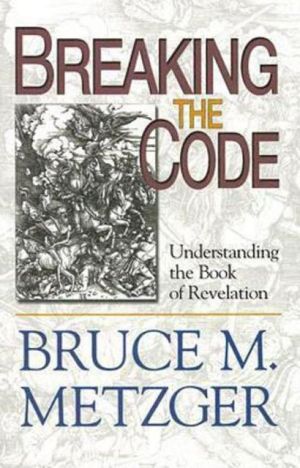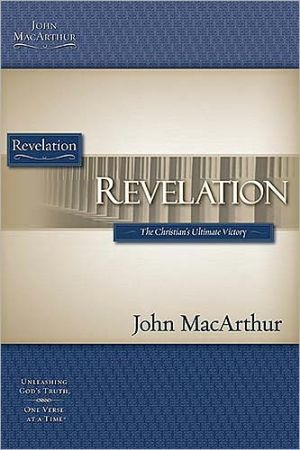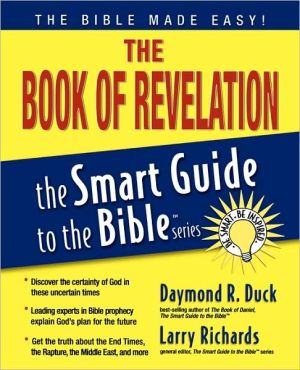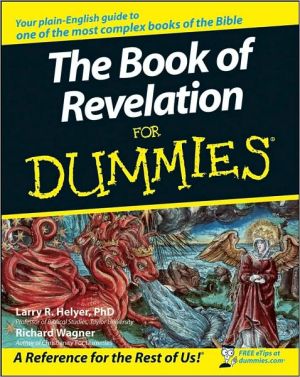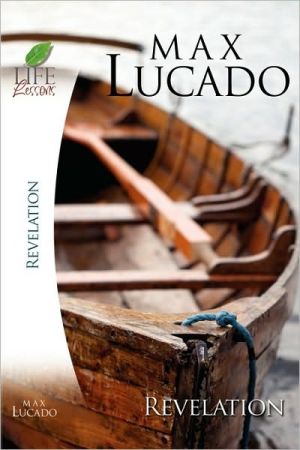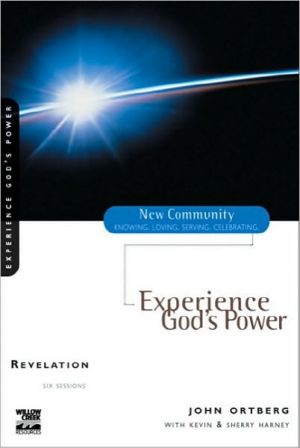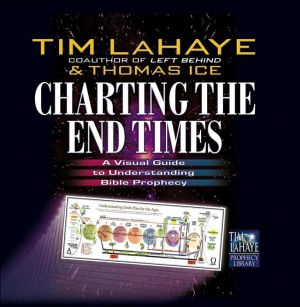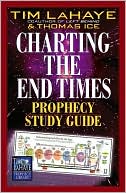Revelation: God's Gift of Hope
Biblical prophecy can be very difficult to understand; as a result, many people simply skip over the books dealing with biblical prophecy. Revelation: God's Gift of Hope provides a helpful Catholic interpretation of perhaps the most mysterious book in the Scriptures. Through this study, participants will see the book of Revelation with new eyes and will grasp hold of its intended, hope-filled message.\ A Guided Discovery of the Bible The Bible invites us to explore God’s word and reflect on...
Search in google:
Created for busy people, Catholic Perspectives: Six Weeks with the Bible is a series of concise, self-contained, one-volume Scripture guides that can be used by individuals or groups. Each guide gives a brief but substantial introduction to a particular biblical book. This series is designed specifically for Catholic adults who want to learn about the Bible and it's applications to daily living but whose busy lives don't give them time to commit to long-term study programs or the exhaustive treatments of annotated study Bibles. This particular volume explores the book of Revelation.
Revelation\ God's Gift of Hope \ \ By Kevin Perrotta \ Loyola Press\ Copyright © 1999 Kevin Perrotta\ All right reserved.\ ISBN: 9780829414356 \ \ \ How to Use This Guide\ \ You might compare this booklet to a short visit to a national park. The park is so large that you could spend months, even years, getting to know it. But a brief visit, if carefully planned, can be worthwhile. In a few hours you can drive through the park and pull over at a handful of sites. At each stop you can get out of the car, take a short trail through the woods, listen to the wind blowing in the trees, get a feel for the place.\ In this booklet we’ll drive through the Revelation of John, making half a dozen stops along the way. At those points we’ll proceed on foot, taking a leisurely walk through the selected passages. The readings have been chosen to take us to the heart of the message John conveys in this letter.\ After each discussion we’ll get back in the car and take the highway to the next stop. “Between Discussions” pages summarize the portions of Revelation that we will pass along the way.\ This guide provides everything you need to explore Revelation in six discussions—or on your own. The introduction on page 6 will prepare you to get the most out of your reading. The weekly sections feature key passages from John’s Revelation, with explanations that highlight what his words mean for us today. Equally important, each section supplies questions that will launch you into fruitful discussion, helping you both to explore Revelation for yourself and to learn from one another. If you’re using the booklet by yourself, the questions will spur your personal reflection.\ Each discussion is meant to be a guided discovery.\ Guided. None of us is equipped to read the Bible without help. We read the Bible for ourselves but not by ourselves. Scripture was written to be understood and applied in and with the church. So each week “A Guide to the Reading,” drawing on the work of both modern biblical scholars and Christian writers of the past, supplies background and explanations. The guide will help you grasp John’s message. Think of it as a friendly park ranger who points out noteworthy details and explains what you’re looking at so you can appreciate things for yourself.\ Discovery. The purpose is for you to interact with John’s letter—and with Jesus, the Lamb of God, whom John describes. “Questions for Careful Reading” is a tool to help you dig into the book and examine it carefully. “Questions for Application” will help you discern what it means for your life here and now. Each week concludes with an “Approach to Prayer” section that helps you respond to God’s Word. Supplementary “Living Tradition” and “Saints in the Making” sections offer the thoughts and experiences of Christians past and present in order to show you what Revelation has meant to others—so that you can consider what it might mean for you.\ How long are the discussion sessions? We’ve assumed you will have about an hour and a half when you get together. If you have less time, you’ll find that most of the elements can be shortened somewhat.\ Is homework necessary? Before you begin, we strongly suggest you read the introductory article, “Getting Your Bearings in This Mysterious Book,” on page 6. As you go through the six weeks, you will get the most out of the discussions if you read the weekly material in advance of each meeting. But if participants are not able to prepare, have someone read the “What’s Happened” and “Guide to the Reading” sections aloud to the group at the points where they occur in the weekly material.\ What about leadership? If you happen to have a world-class biblical scholar in your group, by all means ask him or her to lead the discussions. But in the absence of any professional Scripture scholars, or even accomplished biblical amateurs, you can still have a first-class Bible discussion. Choose two or three people to be facilitators, and have everyone read “Suggestions for Bible Discussion Groups” before beginning (page 92).\ Does everyone need a guide? a Bible? Everyone in the group will need their own copy of this booklet. It contains the sections of Revelation that are discussed, so a Bible is not absolutely necessary—but you should have at least one Bible on hand for your discussion. (See page 96.)\ How do we get started? Take a look at the suggestions for Bible discussion groups (page 92) and individuals (page 95).\ \ Getting Your Bearings in This Mysterious Book\ \ Discipleship certainly seems complicated in today’s world. Being a Christian must have been simpler when it meant hiking around Galilee with Jesus.”\ “In theory, there are points where Christianity conflicts with the business world. In practice it’s almost always unclear where those points are or what to do about them.”\ “I believe Jesus is Lord. But downtown on a Monday morning, it’s not easy to see what that means.”\ Would you be surprised if I told you these scraps of conversation were overheard among parishioners at, say, St. Hugo’s Church in Bloomfield, Michigan, an affluent Detroit suburb? Probably not. What if I told you they were remarks made by Christians less than a century after Jesus’ death and resurrection?\ Actually, the quotes are fictional. But toward the end of the first century a.d., some Christians might have voiced such sentiments, for example, those living in the cities of a region called Asia (present-day western Turkey). Asian cities were competitive, status-conscious, multicultural urban centers closely linked to international trade and finance. Christians in these cities encountered opportunities and difficulties absent from the Jewish villages where Jesus spent most of his life. Christian residents faced difficult questions about how to live as Jesus’ followers when business, politics, and culture were based on pagan values. Leading a Christian life in these cities was as challenging as getting a PC program to run on a Macintosh computer.\ To some of these urban Christians, around the year 90, a respected Church leader named John wrote a lengthy pastoral letter—the letter we know today as Revelation, or the Apocalypse. The author was probably not the man who wrote the Gospel of John, although there is no way to be certain.\ Christians at that time already followed the custom of gathering on Sunday to celebrate the Eucharist, usually in the spacious home of a wealthier member of the community. When John’s letter arrived, the recipients probably read it aloud the next Sunday at their celebration of the Eucharist. When we read Revelation today, we are like guests of those early Christians, sitting next to them as they listen to John’s words.\ We listen because John’s letter speaks to us also. He did not write a list of how-tos for Christian life in first-century Asia (“what kind of inn to avoid when you have to travel as a wine merchant,” “how to choose a not-too-pagan Greek grammar school for your children”). Specific advice like that would be of little use to us. John recognized that his Christian friends needed a fresh, basic vision of Christianity, and he gave it to them. His message continues to give us the big picture of Christianity as we live amid complexities and ambiguities today.\ Revelation contains a message for us, but we must work to get hold of it. John alludes to problems his readers face without bothering to describe them, since they were familiar to his recipients. John also uses an almost psychedelic picture language, different from anything in modern writing. To grasp his message, then, we have to know a little about the social background and about John’s style of writing. These are the matters we will look at in the remainder of this introduction. I apologize for its length, but without sufficient introduction, Revelation will remain mystifying, even misleading.\ Background. The recipients of the letter lived in seven cities in Asia (1:4, 11). Some of these cities were large for their time, with up to a couple of hundred thousand inhabitants. In all of them Christians were a small minority. Except for some Christians and Jews, the inhabitants practiced a blended paganism in which local deities mingled with Greek gods—Greek being the international culture of the day. Ever since the region had become part of the Roman Empire more than a century before, the citizens had also venerated the Roman emperors as divine.\ Pagan religion permeated these ancient cities the way advertising permeates ours. As a resident you would encounter paganism at every turn. Religious statues were set up in houses and on streets and in the places where people conducted business, ran the government, studied, worked out, and bathed. If you were a merchant or a craftsman, you belonged to a business association whose social events featured acts of gratitude to the organization’s patron god. If you became sick, the clinic you went to was located in a shrine to the healing god. If you bought meat in the marketplace, you might be buying portions left over from pagan sacrifices.\ If as a Christian you tried to distance yourself from all this homage to pagan gods, you would offend your relatives, neighbors, and the people you worked for or did business with. They would think you were antisocial and unpatriotic; they might even call you an atheist. They would pressure you to go along with the paganism they considered normal. Refusal could hurt you financially or get you sent into exile—as happened to John (1:9; Patmos was an island used as a place of exile). You might even be killed (2:13).\ All Christians looked for ways to worship only the one God while getting along in the world. But they held a range of views about what degree of accommodation with pagan society was legitimate. Some were rigorous in drawing the line; they insisted on making hard choices and accepting the consequences. Others advocated a relaxed approach to the pervasive paganism.\ In John’s view, the Christians’ eternal destiny and the integrity of the Christian communities were at stake in this confrontation with pagan culture. He wrote to urge his Christian friends to be faithful, public witnesses to Jesus. Addressing both the rigorous and the relaxed, John made a two-pronged appeal. To those suffering losses for their loyalty to Jesus, John offered the assurance that sharing in Jesus’ sufferings means sharing in Jesus’ conquest of death. John warned too-accommodating Christians that compromising with paganism would destroy their relationship with Jesus. Convinced that hostility toward Christianity was going to increase, John wished to encourage faithful but fearful Christians and to put a healthy fear into those who were drifting along complacently with the pagan culture.\ John did not try to settle the many practical issues his readers encountered in their pagan cities. His goal was motivational rather than directive. John pursued his goal by laying before his readers a series of visions that reveal the underlying conflict between the gospel and paganism. Essentially the visions show the coming of God’s kingdom in symbolic form. John hoped that if his readers gained a clearer understanding of God’s action, they would be better prepared to cooperate with it. Seeing where they stood in the big picture, they would be able to take their stand as Christians in their everyday circumstances. If they were sufficiently motivated, they would be able to discern for themselves the requirements of Christian life in their particular situations.\ John’s style of writing. John’s method of communicating divine revelation through symbolic visions is called apocalyptic, which means “revelatory.” Apocalyptic writing was widely used by Jews and then Christians in the period shortly before and after the time of Jesus. This apocalyptic approach was understandable to John’s first readers, but before long, apocalyptic writing went out of style. Less than two hundred years after John, a bishop named Methodius, who lived in the same part of the world, wrote a story in which a character declares that Revelation is full of “tremendous obscurities.” She says, “To find the interpretation and explain it to you is beyond my powers” (although she goes on to offer an interpretation anyway).\ Like other apocalyptic writings, Revelation abounds with grandiose and bizarre apparitions. Symbolic numbers, colors, clothes, and substances mysteriously recur in ever new combinations. Scenes shift abruptly. Anatomically improbable creatures lumber into view. It is little wonder that readers from Methodius’s time until today have struggled to make sense of John’s turbulent stream of images.\ We will explore the meaning of some of John’s images in the “Guide to the Reading” sections—without trying to explain every last detail.\ The time or times John’s visions refer to. John seems to describe the last days. But is John writing only about the end of the world? And is he saying it will come soon? The answers come into focus if we consider Jewish expectations and how Jesus fulfilled them.\ In Jesus’ day many Jews expected God to establish his kingdom in the world. They based their hopes on the way that God had cared for them in the past and on what he had promised through the prophets. Jews expected God to forgive their sins and bring home the scattered twelve tribes of Israel once more, just as he had led Israel in the exodus from Egypt. God would send a messiah, defeat his political enemies, and vindicate his people. God would restore the Jerusalem temple and dwell there in a splendid new way among his people in the Promised Land. There would be tribulation, judgment, resurrection, and lasting peace.\ Jews disagreed about how, when, and in what sequence these events would occur and exactly what they would look like. Generally, however, they expected them to occur in the present world. They did not think that the world was about to end, only that the present age was about to end and a final, wonderful period was about to begin. They called this final period “the last days” or “the end of days” (Daniel 10:14).\ Jesus proclaimed, “The kingdom of God has come near” (Mark 1:15). This announcement signaled that his people’s expectations were about to be fulfilled. But Jesus indicated that he brought God’s kingdom in an unexpected way. He gathered Israel’s twelve tribes by calling twelve disciples to himself; he declared himself to be the temple in which God would dwell among his people. Jesus redefined Israel’s enemies: not principally the Romans, but sin, Satan, and death. And Jesus announced a shocking strategy for overcoming these enemies: dying on a cross and rising from the dead! In this way he would inaugurate the messianic reign, although some aspects of God’s promises would be fulfilled not in the present world but in an eternal kingdom.\ After Jesus’ ascension his followers realized that, in an unexpected fashion, the messianic kingdom has now come. As they put it, “Jesus is Lord!” (see Acts 2:36; Philippians 2:5–11). By his death and resurrection, the last days have arrived (see Acts 2:17; 1 Corinthians 10:11; Hebrews 1:2). But these last days are not a time for Israel to enjoy peace in the Promised Land and to worship God in a renewed Jerusalem temple. The messianic age is marked by the gift of God’s Spirit (Acts 1:1–8; 2:16–21, 33–38). Instead of remaining in the Promised Land in earthly peace, God’s people must now go forth to bear witness to God’s reconciliation to the whole world—a mission that entails suffering as well as blessing. The gathering of Israel, the availability of God’s forgiveness, God’s dwelling among his people—all these promises are now being fulfilled as people everywhere come to believe in Jesus. At the end of these last days the Lord will return to give final judgment, resurrection, and eternal reward.\ With this understanding of Jesus and the last days, let’s go back to Revelation. We can see now that just because John presents visions of the last days does not mean he is speaking only about the end of the world. Like the rest of the early Church, John believed that humanity began to live in the last days when Jesus died and rose from the dead. Thus many of John’s visions concern not the end of the world but the entire period from Jesus’ resurrection to his return—that is, the last days, in which we now live. Our readings in Weeks 1, 3, and 4 will be samples of these visions concerning the present age.\ As you will see, John does use end-of-the-world imagery. This technique creates a tremendous sense of urgency—undoubtedly a deliberately planned effect. But biblical persons sometimes used end-of-the-world imagery not to speak about the end of the world but to show that an event in their own time had ultimate importance. For example, Peter employed such imagery on Pentecost to express the cosmic significance of the gift of the Spirit (Acts 2:19–20).\ In addition to references to the present period of history, some of John’s visions look back to the event that inaugurated the last days: Jesus’ death and resurrection. We will look at a couple of these visions in Weeks 2 and 4. Other visions look forward to the final judgment by which God will bring the last days to an end (Weeks 3 and 5). Finally, some visions give us a glimpse of the eternal kingdom after the end of the world (Weeks 3 and 6).\ Because John is the only New Testament author to write mainly in an apocalyptic style, his message may seem different from that of the other writers of the New Testament. But in reality his book is simply a variation on central New Testament themes. The New Testament writers describe the unexpected way that God has brought his kingdom through Jesus. John illustrates this through a wide range of symbolic images. New Testament authors demonstrate that Jesus fulfills the promises God made to Israel. John does this too, by weaving together many allusions to the Old Testament, especially allusions to God’s judgment, the gathering of the twelve tribes, and God’s presence with his people in a restored temple. Finally, like other New Testament authors, John attempts to bring home to his readers what all of this means for them in their particular situation.\ John’s visions were intended to speak to his urban Christian friends about their powerlessness in a pagan society dominated by the Roman emperor. John showed that the real emperor of the universe is Jesus. He portrayed the defeat of the ferocious evils that sought to deceive and destroy Christians. He showed them that, like Jesus, Christians conquer evil when they choose to be “conquered” by persecution rather than abandon their testimony to God’s love. To stir their hope, John gave them an insight into the wonderful life that God prepares for those who are faithful.\ John tailored his message to the readers of his day. Thus he did not fill his letter with specific references to the twentieth and twenty-first centuries, as some people suppose. What good would that have been to his readers? A message loaded with cryptic references to oil wells, ballistic missiles, China, and Russia would not have been much of a word of the Lord to them. Jesus commissioned John to give his readers a message to keep (1:1–3; 22:7), that is, a message to live by, not one to put in an archive for use two thousand years later.\ A question about timing remains. Did John think his visions of the final judgment would be fulfilled in his own day? In other words, did he expect the end of the world at the end of the first century? At first John’s letter may give the impression that he thought the end of the world was imminent, but on closer examination the answer is not so simple.\ John’s visions shuttle back and forth between past, present, and future with few indicators regarding which historical times they correspond to. For example, in one vision John reports that five kings have passed from the scene, one is, and one is yet to come (17:10), but he does not say what historical moment, if any, this vision refers to.\ John uses the word soon and speaks of brief periods, such as “forty-two months” (11:2). He says, “The time is near” (1:3). If taken literally, these terms would suggest that he expected the end of the world in the near future. But John’s language is heavily symbolic. In any case, other symbols suggest that the end will not arrive for a long time. A “thousand years” must pass, and a huge number of martyrs’ places—144,000—must be filled before the end (6:11; 7:4–9; 20:4).\ John does communicate a conviction that age-old evils are reaching a climax in the idolatrous, materialistic, and unjust Roman Empire. But he does not close off the possibility that these evils may yet manifest themselves in other governments and economic systems in the future.\ Thus John’s letter continues to have meaning for us, who know that the last days have turned out to be a very long period indeed. What John says about the last days continues to give us insight into the spiritual dynamics of our world. This is the approach to interpreting Revelation that many Christians have taken since the time of St. Augustine in the fourth century, and it is the approach we will take in this booklet.\ In closing, here are a few suggestions for getting the most out of your reading and discussion.\ Focus on the main issues. Don’t get lost in the details. In Revelation a single detail can be incredibly rich, and when the details are combined, the complexity is endless. Fight the temptation to get bogged down and bewildered.\ Don’t try to understand the entire book all at once. Avoid mental overload! Identify a few points, and ponder what they mean for you.\ Ask the Holy Spirit to guide you. He was John’s coauthor in the writing of this letter. Let him be your coreader also.\ \ Week 1\ He Keeps the\ Lamps Burning\ \ Questions to Begin\ 15 minutes\ Use a question or two to get warmed up for the reading.\ 1 What images of Jesus in religious art (paintings, icons, statues, stained-glass windows) are particularly meaningful for you? Why?\ 2 What is your attitude toward reading and discussing the book of Revelation?\ Maybe I’ll finally find out what 666 stands for.\ Who do we think we are? Isn’t this the most difficult book in the Bible?\ I’ve always wanted to read Revelation for myself.\ I just hope no one in the group is going to try to preach their pet theories about the end of the world.\ With all the judgments and weirdness, is this really a book that Christians can benefit from reading?\ This promises to be really interesting!\ \ Opening the Bible\ 5 minutes\ Have someone in the group read “The Reading” aloud. (If participants have not already read “What’s Happened,” read\ that aloud also. Otherwise skip it.)\ \ What’s Happened\ For the first reading of John’s letter, the Christians he wrote to were gathered together for the Eucharist. His opening perfectly suited the liturgical setting. He blesses the liturgical reader and listeners and announces that they are about to hear a word from the Lord (1:1–3). He offers a prayer to Jesus before beginning (1:5–6). He concludes with a solemn word from God, preparing his readers for an awesome message: “ ‘I am the Alpha and the Omega,’ says the Lord God, who is and who was and who is to come, the Almighty” (1:8).\ The Reading: Revelation 1:9–20; 2:18–29\ A Vision of the Risen Lord\ 9 I, John, your brother who share with you in Jesus the persecution and the kingdom and the patient endurance, was on the island called Patmos because of the word of God and the testimony of Jesus. 10 I was in the spirit on the Lord’s day, and I heard behind me a loud voice like a trumpet 11 saying, “Write in a book what you see and send it to the seven churches, to Ephesus, to Smyrna, to Pergamum, to Thyatira, to Sardis, to Philadelphia, and to Laodicea.”\ 12 Then I turned to see whose voice it was that spoke to me, and on turning I saw seven golden lampstands, 13 and in the midst of the lampstands I saw one like the Son of Man, clothed with a long robe and with a golden sash across his chest. 14 His head and his hair were white as white wool, white as snow; his eyes were like a flame of fire, 15 his feet were like burnished bronze, refined as in a furnace, and his voice was like the sound of many waters. 16 In his right hand he held seven stars, and from his mouth came a sharp, two-edged sword, and his face was like the sun shining with full force.\ 17 When I saw him, I fell at his feet as though dead. But he placed his right hand on me, saying, “Do not be afraid; I am the first and the last, 18 and the living one. I was dead, and see, I am alive forever and ever; and I have the keys of Death and of Hades. 19 Now write what you have seen, what is, and what is to take place after this. 20 As for the mystery of the seven stars that you saw in my right hand, and the seven golden lampstands: the seven stars are the angels of the seven churches, and the seven lampstands are the seven churches. . . .\ A Report Card for the Church\ 2:18 “To the angel of the church in Thyatira write: These are the words of the Son of God, who has eyes like a flame of fire, and whose feet are like burnished bronze:\ 19 “I know your works—your love, faith, service, and patient endurance. I know that your last works are greater than the first. 20 But I have this against you: you tolerate that woman Jezebel, who calls herself a prophet and is teaching and beguiling my servants to practice fornication and to eat food sacrificed to idols. 21 I gave her time to repent, but she refuses to repent of her fornication. 22 Beware, I am throwing her on a bed, and those who commit adultery with her I am throwing into great distress, unless they repent of her doings; 23 and I will strike her children dead. And all the churches will know that I am the one who searches minds and hearts, and I will give to each of you as your works deserve.\ 24 “But to the rest of you in Thyatira, who do not hold this teaching, who have not learned what some call ‘the deep things of Satan,’ to you I say, I do not lay on you any other burden; 25 only hold fast to what you have until I come.\ 26 “To everyone who conquers and continues to do my works to the end,\ I will give authority over the nations;\ 27 to rule them with an iron rod,\ as when clay pots are shattered—\ 28 even as I also received authority from my Father. To the one who conquers I will also give the morning star. 29 Let anyone who has an ear listen to what the Spirit is saying to the churches.”\ \ Questions for Careful Reading\ 10 minutes\ Choose questions according to your interest and time.\ \ 1 In the first vision, what does Jesus do with his right hand (see 1:16–17)? What significance does the gesture in verse 17 gain from the fact that it is done with the same hand that performs the action in verse 16?\ 2 Some images are probably not meant to be pictured; for example, the sword coming from Jesus’ mouth suggests the power of his words. What other images do you think should be understood for their meaning but not taken as pictorial?\ 3 Why does John make a point of referring to himself as “I, John, your brother who share with you in Jesus the persecution and the kingdom and the patient endurance” (1:9)?\ 4 What phrases or images from John’s vision of Jesus in 1:9–20 reappear in the message to Thyatira (2:18–29)?\ 5 What images or ideas in this reading are puzzling or troubling? Why? Write them down and see whether they become clearer through reading further sections of Revelation and the guides to the reading.\ A Guide to the Reading\ If participants have not read this section already, read it aloud. Otherwise go on to “Questions for Application.”\ \ John draws a picture of Jesus that is strikingly different from the one we find in the Gospels. Is Jesus now a heavenly being with burning eyes and metal feet (1:14–15)?\ No. John received a vision of Jesus so awesome as to be beyond description (see 1:17). Yet he must find human terms to convey it, so he communicates his vision symbolically. To represent Jesus’ heavenly priesthood, John describes priestly clothing (1:13); for Jesus’ divine splendor, white hair (1:14); for penetrating knowledge, fiery eyes (1:14); for unshakable stability, bronze feet (1:15); for supreme authority, a handful of stars (1:16). Each picture contributes an idea, and the ideas add up to a statement: having conquered death by his death and resurrection, Jesus shares the powers and majesty of God (1:18). The ideas fit together; the images, not quite. Jesus does not literally have white hair and a sword coming from his mouth. Yet the overall picture gives a sense of Jesus’ grandeur. The picture stirs the imagination, even if it would resist being drawn.\ Jesus calls himself “the first and the last” (1:17)—a phrase God applied to himself in the Old Testament (Isaiah 44:6). Biblical scholar George Beasley-Murray writes that Jesus is “the initiator of all things and the finisher of God’s purposes for his creation.”\ Real estate agents say that three factors determine the market value of a house: location, location, location. Location also establishes the meaning of John’s vision of Jesus. Jesus is surrounded by fixtures that support oil lamps (1:12). Priests kept the lamps burning in the Jerusalem temple. Jesus, then, is acting like a priest by taking care of the lamps, which here symbolize the churches (1:20). Jesus is about to give John messages and visions that will correct and encourage the churches. This will be Jesus’ means of cleaning out dirty lamps, putting in new wicks, and filling the lamps with oil.\ The vision shows that Jesus does not direct his people from a distance; he is among us, making sure the light of divine life in us continues to burn. John’s vision symbolizes Jesus’ promise “I am with you always, to the end of the age” (Matthew 28:20). Because Jesus faithfully tends his Church, the Church as a whole can never go astray from God, despite the sins and failings of its members.\ Jesus commissions John to deliver messages to seven churches (chapters 2–3). Throughout Revelation, the number seven signals completeness, so to say the letters are directed to seven churches means they are meant for the entire Church.\ In the message to the Christians in Thyatira, we see Jesus’ fiery, all-knowing eyes probing the situation of a particular church community (2:18, 23; compare 1:14). He finds not only faithful service (2:19) but also a problem that needs to be set right.\ Thyatira was a small-scale manufacturing and commercial city. The craftsmen and merchants generally belonged to guilds, and the social occasions sponsored by the guilds presented problems for Christians because the celebrations involved offering homage to the association’s patron god and eating meat sacrificed to the god. They sometimes also ended in sexual immorality. Could believers square such practices with their commitment to Jesus?\ It was bad for business to get excluded from the guild for refusing to join in such pagan rites. So Christian businesspeople must have felt relieved to hear the soothing advice that some Christians offered: “It’s okay to go along with the pagan rites. They don’t mean anything anyway, since pagan gods do not really exist.”\ Jesus calls the community members who are giving this compromising advice “Jezebel” (2:20). The name is used symbolically; the original Jezebel was a queen of foreign origin who led the Israelites into idolatry (1 Kings 16:31; 18:4, 13, 19). Here “Jezebel” may refer to an individual. But “Jezebel,” “those who commit adultery with her” (2:22), and “her children” (2:23) may simply be different ways of referring to a segment of the church.\ If the compromisers do not change their ways, sickness (2:22) and death (2:23) are in store for them. Just as the compromising behavior is described symbolically (“fornication” and “adultery”—2:20–22—are often used in Revelation to refer to idolatry), the references to punishment are also symbolic. Perhaps sickness and death represent the compromisers’ exclusion from the Christian community and a rupture of relationship with Jesus.\ \ Questions for Application\ 40 minutes\ Choose questions according to your interest and time.\ \ 1 John says we receive a mixture of hardship, blessing, and help from God through belonging to Jesus (1:9). Describe a situation in which you experienced this combination. What have you learned from it?\ 2 When has Jesus brought you a message of encouragement? a message of correction? What effect did these messages have on you?\ 3 If you were to guess at the message of encouragement and correction Jesus would give you today, what do you think it would be? How do you think you should respond?\ 4 Is there a “Jezebel” voice in you that assures you certain sins are really okay? What arguments does it use? Do you listen?\ \ 5 When are you tempted to downplay or even deny your faith in Jesus?\ 6 What could you do to listen more carefully to Jesus’ words to you?\ \ Approach to Prayer\ 15 minutes\ Use this approach—or create your own!\ \ ♦ Begin by having someone read this blessing to the group, adapted from Revelation 1:3:\ Blessed is the one who reads aloud the words of the prophecy, and blessed are those who hear and who keep what is written. Blessed are those who listen for God’s voice and respond to his words to them.\ Let someone else read Revelation 1:17–18:\ Do not be afraid; I am the first and the last, and the living one. I was dead, and see, I am alive forever and ever.\ Then suggest this meditation:\ Picture Jesus in the way that comes most naturally to you. Picture yourself with Jesus. Ask him to let you look at his evaluation of you, which he holds in his hand. Then talk it over with him.\ Allow some minutes for silent reflection. End by praying the Our Father together.\ \ Saints in the Making\ Which Side of the Fence Was I Really On?\ This section is a supplement for individual reading.\ \ The last of Revelation’s seven messages is addressed to the Christians in Laodicea. Jesus chastises them severely: “You are neither cold nor hot. . . . So, because you are lukewarm, . . . I am about to spit you out of my mouth” (3:15–16). The imagery probably alludes to the mineral-spring water that flowed through Laodicea. The brackish water, which caused violent retching, was lukewarm. By contrast, neighboring cities had healthful springs, one hot, the other cold. This image seems to refer to some condition in the Laodicean church that was spoiling the Christians’ relationship with Jesus. Apparently the problem lay in their acceptance of Laodicea’s complacent materialism (see 3:17).\ How Christians today might respond to this message is suggested by the experience of a California woman named Jean Marie Rencher. She was dissatisfied with a lifestyle that kept her busy all the time but never left her feeling that she did anything well. As she mulled over her situation one day, she recalled Revelation 3:15–16, which had recently been read at Mass. “I had thought these harsh words at the time,” she wrote. “Now I wondered if this was because they applied to me. I had been intending to be more committed to the Lord . . . after I got my own problems worked out. Now it seemed I had been given an ultimatum. Maybe I should decide which side of the fence I was really on.”\ Rencher rearranged her priorities. She quit her part-time job to have more time for her children, prayer, and needy neighbors. This commitment meant living on a smaller income, but she found that her family “was finding time to enjoy quiet pleasures.”\ The financial pinch drove Rencher to ask God for help. When one prayer was answered in an especially striking fashion, she and her husband found their faith in God reawakened. Wanting to reinforce their excitement “with something more substantial,” they joined a Bible study and began to explore the meaning of the Mass.\ Several years later, Rencher declared that her decision to respond to God’s words in Revelation continued to deepen her relationships with her family, the Church, and God.\ \ In the remainder of chapters 2 and 3, John conveys messages from Jesus to Christian communities in six other cities of Asia. In all of them Christians face hostility. Jesus commends two communities for their faithfulness and warns of stiffer challenges to come (2:9–10; 3:8–10). He takes two communities to task for failing to correct members who are promoting compromise with the pagan culture. The compromisers, called false apostles, followers of Balaam, and Nicolaitans (2:2, 14–15), are probably like the Jezebel group at Thyatira (2:20). In one community, those who remain faithful to Jesus constitute only a minority (3:1–4). The seventh community has drifted into a condition of total compromise: it is “lukewarm” (3:16). Thus everywhere a battle rages for the soul of the Christian communities, sometimes most fiercely among those who are least aware of it. In the next seventeen chapters John will use flamboyant imagery to depict this spiritual conflict.\ If we are to understand John, we must recognize the thoroughly symbolic nature of his visions. It would be almost impossible to emphasize this point too strongly. Numbers, times, places, names, behavior (fornication and prostitution, conquering and ruling, washing and singing), and things that happen to people (being burned up, gaining access to the tree of life) are all symbolic.\ Indeed, there are multiple layers of symbolism. As we have seen, seven stars are said to be seven angels (1:20), but the angels themselves are symbolic—in this case representing the Church’s heavenly nature and call. At just about every line of Revelation you could take a pen and write in the margin, “This is symbolic” and “This too is symbolic.”\ Therefore we must beware of taking anything in Revelation literally. For example, when we begin reading about God’s sending judgments on the world (Week 3), we will need to keep in mind that the visions of wars, famines, and other catastrophes are not literal depictions. The visions do not convey information about historical events; they convey meaning. The visions help answer questions: What really happened when Jesus died on a cross? How does Jesus exercise his divine authority over the sinful human world? Where is God when Christians are persecuted by a pagan society? What is God doing when human beings destroy each other through warfare? What is the inner nature of the final fulfillment God prepares for us? The visions are neither sneak previews of tomorrow’s news nor blueprints for the end of the world.\ Nor do the visions contain tomorrow’s news in code. Traffic signals are a kind of code. A green light simply means go. The greenness of the light does not say anything about the quality of going; the code of traffic signals does not suggest that the experience of going is greenish. Symbols, however, do make these kinds of connections. The roses I give my wife, for example, are symbolic. They are not a code telling her that today is our anniversary. Rather they are a symbol. Their loveliness represents her loveliness. Their freshness represents the freshness of my love for her. Their similarity to the roses I gave her the first time we went out reminds us of all the years since then.\ We use symbols to speak about things too profound or complex or mysterious to be dealt with in a more direct fashion. My love for my wife is like that, so on our anniversary, I “say it with flowers.” John is also dealing with matters that are profound, complex, and mysterious: Jesus’ negation of death by his death, martyrs’ entry into eternal life through being crushed by a hostile world, the victory of God’s self-sacrificing love over self-aggrandizing human evil. John has said it not with flowers but with thrones, trumpets, kings, women, fire, and precious stones.\ If Revelation were a prediction in code, it would be a self-defeating attempt at communication. John would have done better to decode the visions himself and tell us what they mean. That would have saved a lot of confusion. But his language is symbolic, and thus deeply instructive. John uses fire, for example, as a symbol of God’s judgment. Since it is a symbol, it tells us no more about the literal nature of God’s judgment than roses tell us about the literal nature of marriage. Yet as a symbol, fire conveys something we need to know: coming under God’s judgment, like getting burned, is painful. The symbol gives us a sense of how strongly and instinctively we should seek to avoid that judgment.\ \ \ \ \ Continues... \ \ \ \ Excerpted from Revelation by Kevin Perrotta Copyright © 1999 by Kevin Perrotta. Excerpted by permission.\ All rights reserved. No part of this excerpt may be reproduced or reprinted without permission in writing from the publisher.\ Excerpts are provided by Dial-A-Book Inc. solely for the personal use of visitors to this web site. \ \
Contents\ 4 How to Use This Guide\ 6 Getting Your Bearings in This Mysterious Book\ 14 Week 1\ He Keeps the Lamps Burning\ Revelation 1:9–20; 2:18–29\ 26 Week 2\ The Lamb Ascends the Throne\ Revelation 4:1–5:13\ 38 Week 3\ Bending Evil to His Purposes\ Revelation 6:1–17; 8:1\ 50 Week 4\ The Lady and the Dragon\ Revelation 12:1–17\ 62 Week 5\ Look, a White Horse!\ Revelation 19:11–20:10\ 74 Week 6\ A City Coming Down from Heaven\ Revelation 21:9–22:5\ 86 A Little of the Beast in All of Us\ 92 Suggestions for Bible Discussion Groups\ 95 Suggestions for Individuals\ 96 Resources

